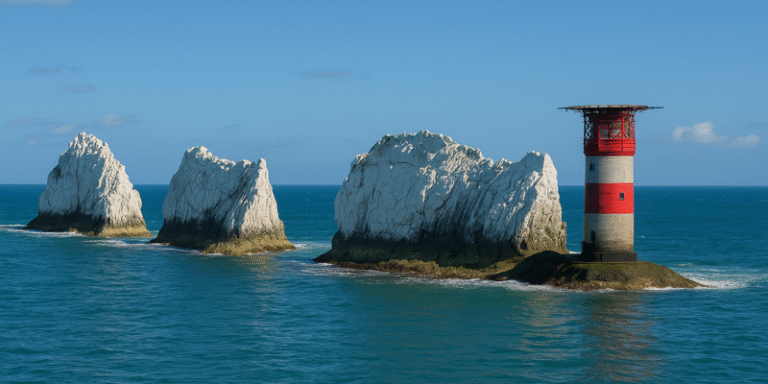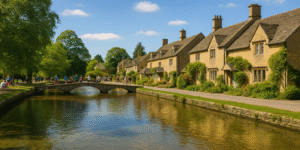Perched dramatically off the western tip of the Isle of Wight, the Needles is one of the United Kingdom’s most iconic coastal landmarks. With its towering white chalk stacks, historic lighthouse, and sweeping sea views, the Needles offers more than just a postcard-perfect sight; it embodies centuries of geological history, naval heritage, and tourist appeal. This article explores the natural formation, historical importance, and modern-day charm of this celebrated site, reflecting its multifaceted significance for both locals and visitors alike.
Geological Marvel: The Making of the Needles
The Needles are a series of three distinctive chalk stacks that rise starkly from the sea. Once part of a chalk ridge that connected to the mainland, their formation is a tale told by time, erosion, and tectonic activity. The striking white cliffs are remnants of a once-continuous ridge that stretches from the Isle of Purbeck, Dorset, across the Solent (Booth and Brayson, 2011). Over millennia, the sea wore down the connecting land, isolating the Isle of Wight and forming these vertical rock pillars.
Interestingly, the name “Needles” is misleading—originally there was a fourth stack shaped like a needle, known as Lot’s Wife, which collapsed in a storm in 1764 (Simpson, 2018). The remaining formations, though broader and more robust, continue to carry the legacy of this vanished spire.
From a scientific perspective, the Needles have drawn considerable interest due to their unique geology. They form part of the Cretaceous chalk strata, offering crucial insights into the Earth’s ancient climate and sedimentary processes (Munt, 2008). As such, they are included within UNESCO’s proposed Global Geopark for the Isle of Wight, which celebrates their scientific and educational value (Downes, 2021).
A History Etched in Stone and Sea
Beyond its natural grandeur, the Needles is steeped in naval and wartime history. The Needles Battery, a Victorian coastal defence site constructed between 1861 and 1863, was part of a broader strategy to defend against French invasion. It later played a key role during both World Wars and was a site for top-secret rocket testing during the Cold War era (Tomalin et al., 2000).
Perched on the clifftop, the Old Battery and New Battery sites now operate as National Trust attractions, giving visitors a glimpse into the military past of the area. These structures blend historical significance with panoramic views, offering an atmospheric contrast to the natural environment.
Tourism: From Victorian Curiosity to Modern-Day Attraction
The rise of Victorian seaside tourism in the 19th century saw the Isle of Wight become a fashionable escape for Britain’s urban populations, with the Needles serving as a major highlight (Booth and Brayson, 2011). The arrival of paddle steamers and later, ferries, made the western coast accessible to increasing numbers of tourists.
Today, the Needles is a centrepiece of the island’s tourism economy, drawing nearly half a million visitors annually (Visit Isle of Wight, 2023). The site features several attractions including the Needles Landmark Attraction, a family-oriented park offering chairlift rides down to Alum Bay, amusement arcades, and interactive history exhibits.
One of the most popular features is the chairlift, which glides over the cliff edge, giving a bird’s-eye view of the brilliant multi-coloured sand cliffs of Alum Bay and the crystalline waters below. This thrilling perspective showcases the interplay of coastal erosion and geological layering, making it a favourite for both tourists and photographers.
Geotourism and Conservation Challenges
The popularity of the Needles also brings with it a need for responsible tourism and environmental stewardship. The chalk cliffs and surrounding habitats are vulnerable to both natural erosion and human activity. According to Hose (2025), balancing commercial tourism with geoconservation is one of the primary challenges facing such coastal landmarks.
The Isle of Wight Council, in conjunction with conservation bodies like the National Trust and Natural England, has implemented visitor management strategies. These include path rerouting to avoid cliff-edge erosion, interpretation signage to educate the public, and preservation of the biodiversity of the maritime grasslands and cliffside flora (Simpson, 2018).
The Needles Lighthouse: Guiding Light of the Solent
Standing sentinel at the westernmost stack is the Needles Lighthouse, completed in 1859. Built to replace an earlier land-based light, it remains a vital aid to navigation, warning vessels of the dangerous rocks in the busy shipping lanes of the Solent. The lighthouse was automated in 1994, but its legacy remains central to the maritime identity of the region (Turner, 2023).
The lighthouse, operated by Trinity House, is not open to the public, but boat tours frequently pass close to it, offering stunning views and photographic opportunities. The image of the Needles Lighthouse against a setting sun is often used to symbolise the Isle of Wight itself.
Cultural Significance and Artistic Inspiration
The Needles has long captivated artists, writers, and poets. From Romantic painters in the 1800s to modern-day travel bloggers and filmmakers, its awe-inspiring form and location have made it a muse for the creative spirit. Literary references can be found in Victorian guidebooks and modern travelogues alike.
Moreover, it has become a cultural icon of the Isle of Wight, featured on souvenirs, local branding, and promotional campaigns. The site holds deep meaning for locals, many of whom have memories of school trips or summer visits to the landmark.
A Timeless Destination
Whether admired for its natural beauty, geological intrigue, military history, or touristic flair, the Needles remains a timeless destination. It exemplifies the intersection of nature and culture, where chalk cliffs tell ancient stories and wind-swept lookouts recall tales of defence and discovery.
In the face of climate change and rising tourism numbers, the future of the Needles depends on sustainable management and public engagement. With the right balance, it will continue to inspire and educate for generations to come.
References
Booth, K.A. and Brayson, J. (2011). Geology, landscape and human interactions: examples from the Isle of Wight. Proceedings of the Geologists’ Association, 122(1), pp.61–76.
Downes, J. (2021). Isle of Wight: Landscape and Geology. London: HarperCollins.
Hose, T.A. (2025). Travel, Sea Air and (Geo)Tourism in Coastal Southern England. Tourism and Hospitality, 6(3), pp.155–174.
Munt, M. (2008). A history of geological conservation on the Isle of Wight. In: Geological Conservation Review Series. London: Natural England.
Simpson, M. (2018). Geotourism and Geoconservation on the Isle of Wight, UK: Balancing science with commerce. Geoconservation Research, 1(1), pp.45–59.
Tomalin, D.J., Simpson, P., and Haskins, C. (2000). Sustainability in situ: Archaeological investigations at Goose Rock, the Needles. International Journal of Nautical Archaeology, 29(1), pp.89–109.
Turner, W. (2023). A-Z of the Isle of Wight: Places, People, History. Stroud: Amberley Publishing.
Visit Isle of Wight (2023). Visitor Economy Strategy Report. Available at: https://www.visitisleofwight.co.uk [Accessed 20 Aug. 2025].









